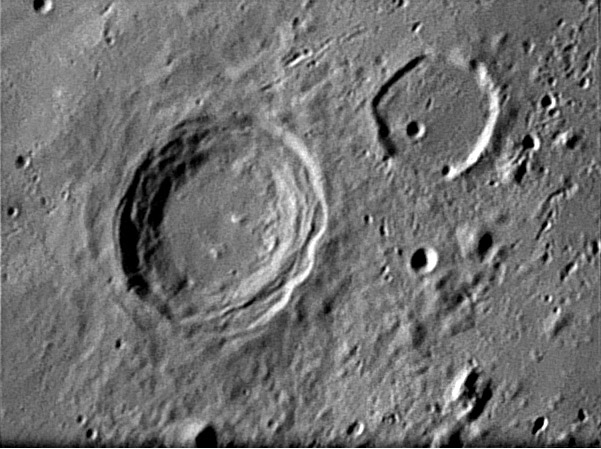
image by François Emond, Hautes-Alpes, FRANCE.
Although there have been about 1,200 LPODs, not every one of the 1,229 nearside named features has had its own page. The problem is that a handful of craters grab attention, so that every imager has their personal best Plato, Clavius, Copernicus, Gassendi, Tycho and Theophilus, all of which are submitted to LPOD. And I publish them when I can find something new to say - or am too awestruck to say much of anything. As a strike for fairness, today LPOD shows the interior of an often overlooked crater that has previously been depicted only under very low illumination. Reinhold lives in the shadow of Copernicus (not the real shadow, but a shadow of neglect due to being too near a superstar to be noticed), and has even been pelted by its secondaries and swathed by its rays. Reinhold (diameter 42 km) is an atypical complex crater because it has just two small off-center hills rather than a massive central peak like its more normal neighbor 38 km wide Lansberg. I don’t know why some complex craters lack substantial central peaks, but many in this category formed on basin ejecta, which may have been too incoherent to form massive peaks. François’ image hints at a central dip between the two hills. Craters formed on Mars and Jupiter’s icy satellites often have central pits instead of peaks because a subsurface ice layer evaporates rather than rebounding. A pit on the Moon would not have the same origin, but perhaps settling of highly fractured rocks in the center could cause the dip. In fact, another of François’ images, of ['http://lpod.org/coppermine/displayimage.php?pos=-2853 Aristoteles], another crater lacking a significant peak, hints at a dip between its small peaks. Is this true for other complex craters with small, off-center peaks?
Technical Details:
06/08/07, 04h12 UT. Dobson T400 (16″) & barlow FFC + extension tubes. Webcam Vesta Pro N & B mode raw + red filter RG630. Processed with Iris.
Related Links:
Rükl plate 31
François’ website.
Now you can support LPOD when you buy any book from Amazon thru LPOD
COMMENTS?
Click on this icon File:PostIcon.jpg at the upper right to post a comment.



